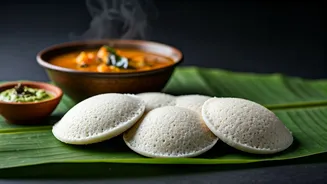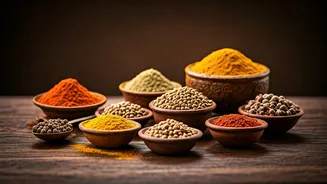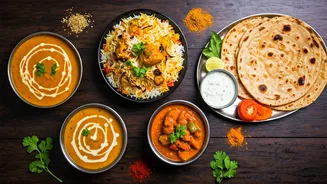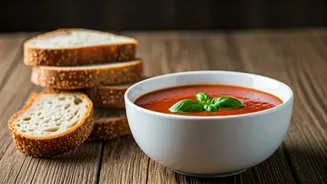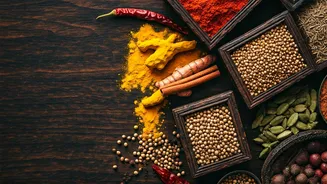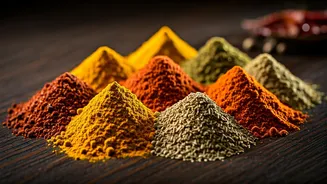India's Culinary Tapestry
India's culinary landscape is as diverse as its geography. Each region boasts its unique cooking style, ingredients, and dishes. In the north, you'll find
creamy curries and tandoori preparations, heavily influenced by Mughal traditions. The south, on the other hand, is known for its use of rice, lentils, and coconut milk, creating flavorful vegetarian dishes and spicy seafood specialties. Moving towards the east, you will witness the emphasis on fish and rice, showcasing the impact of the Bengal region. Meanwhile, the west celebrates the use of local produce, incorporating unique flavors, such as the famous Gujarati thali with sweet, sour, and savory components. This wide variety highlights India's rich culinary traditions.
Spice Symphony Unveiled
Spices are at the heart of Indian cooking, transforming simple ingredients into complex and aromatic dishes. The use of spices is not just about flavor; it's a deep-rooted cultural tradition. Common spices include turmeric, known for its vibrant color and anti-inflammatory properties, cumin, which adds an earthy flavor, and coriander, used for its fresh and citrusy notes. Chilli powder is there to bring the heat and cardamom to bring the aroma. These spices are not just thrown together; rather, they are carefully blended and balanced to create a harmonious taste. The art of spice usage takes years to master, and it differs with various regions and households. The selection and processing of spices can significantly affect the flavor of a dish.
Mastering Spice Blends
The secret to authentic Indian cooking lies in the proper use of spice blends. Garam masala, a blend of roasted ground spices, is a staple, adding warmth and depth to many dishes. Sambar powder, used in South Indian cuisine, combines lentils, spices, and chilies to create a complex and flavorful base for the sambar. The creation of such spice blends differs from family to family and region to region, and can also vary based on the availability of ingredients. For beginners, it's wise to start with store-bought blends, but as your understanding grows, you can start experimenting with your own combinations. The key is to roast the spices until they release their aroma and then grind them to a fine powder for the best flavor release. Experimenting with different blends will help to create unique flavors.
Curries: A Flavor Spectrum
Curries are the stars of Indian cuisine, with an endless variety of flavors, textures, and ingredients. Butter chicken, a rich and creamy tomato-based curry, is a favorite across India and the world. Palak paneer, a vegetarian dish with spinach and Indian cheese, is both healthy and delicious. Rogan josh, a lamb curry from Kashmir, is characterized by its deep red color and complex flavors. The base of most curries typically starts with onions, ginger, garlic, and tomatoes, which are cooked to form a flavorful base, to which various spices, herbs, and other ingredients are added. The consistency of the curry also varies depending on the region and the dish, going from thin and soupy to thick and creamy. The skill lies in balancing the spices and using the correct cooking techniques to bring the flavors to life.
Bread and Rice Delights
No Indian meal is complete without its bread and rice accompaniments. Naan, a leavened flatbread baked in a tandoor oven, is perfect for scooping up curries. Roti, an unleavened flatbread, is a staple across India. Paratha, a layered flatbread, can be plain or stuffed with vegetables or spices. Rice, a staple in many parts of India, is often served plain, but can also be flavored with spices. Biryani, a mixed rice dish with meat or vegetables, is a festive favorite, known for its layered textures and flavors. These breads and rice varieties add variety, and texture and complete the dining experience. Understanding the correct methods of cooking rice and baking the bread helps in enjoying the complete flavors of Indian cuisine.
Vegetarian Culinary Treasures
Vegetarian cuisine is extremely important in Indian culture, with a wide array of vegetarian dishes using lentils, vegetables, and paneer (Indian cheese). Dal, made from lentils, is a staple, with many versions to pick from, ranging from simple to elaborate. Vegetable curries, utilizing a broad selection of seasonal vegetables, offer numerous flavors. Paneer dishes, such as palak paneer and shahi paneer, are loved for their taste and texture. Vegetarian dishes demonstrate the vastness and versatility of Indian cooking and are also suitable for various dietary needs. The use of fresh ingredients and creative blending of spices gives vegetarian dishes a rich taste.
Desserts: Sweet Endings
Indian desserts are known for their sweetness and richness. Gulab jamun, deep-fried milk balls soaked in syrup, is a popular choice. Rasgulla, spongy cheese balls in sugar syrup, is a beloved Bengali sweet. Kheer, a rice pudding flavored with cardamom and nuts, is often served during festivals. Halwa, made from semolina or other ingredients, is another popular sweet. These desserts reflect India's love for sweetness and are commonly prepared for festive occasions or celebrations. They often feature milk, nuts, and aromatic spices to add to their richness. The variety of textures and tastes ensures that there is a dessert for every palate.
Regional Indian Specialties
Each Indian region has its food specialty. In Punjab, butter chicken and paratha are widely enjoyed. In Bengal, fish curries and sweets are very popular. In Maharashtra, the pav bhaji (vegetable curry served with bread) is a famous street food. Andhra Pradesh is known for its spicy cuisine, and the biryanis in Hyderabad are very famous. These regional specialties show the range of Indian cuisine, highlighting local ingredients, spices, and cooking styles. Exploring these diverse flavors and dishes, it is possible to experience the vastness of Indian culinary culture.
Cooking Indian at Home
Recreating Indian dishes at home can be a rewarding experience. Start with basic recipes to get familiar with the spices and techniques. Use good quality ingredients, especially spices, for the best flavor. Don't hesitate to experiment with different spice combinations to fit your taste. Explore numerous online sources and cookbooks to increase your knowledge. Preparing Indian food at home allows you to control the ingredients and adjust the spice levels. It is a fantastic way to enjoy delicious, healthy meals while appreciating the rich cultural background of Indian cooking. Remember, the key is to have fun and discover new flavors!


